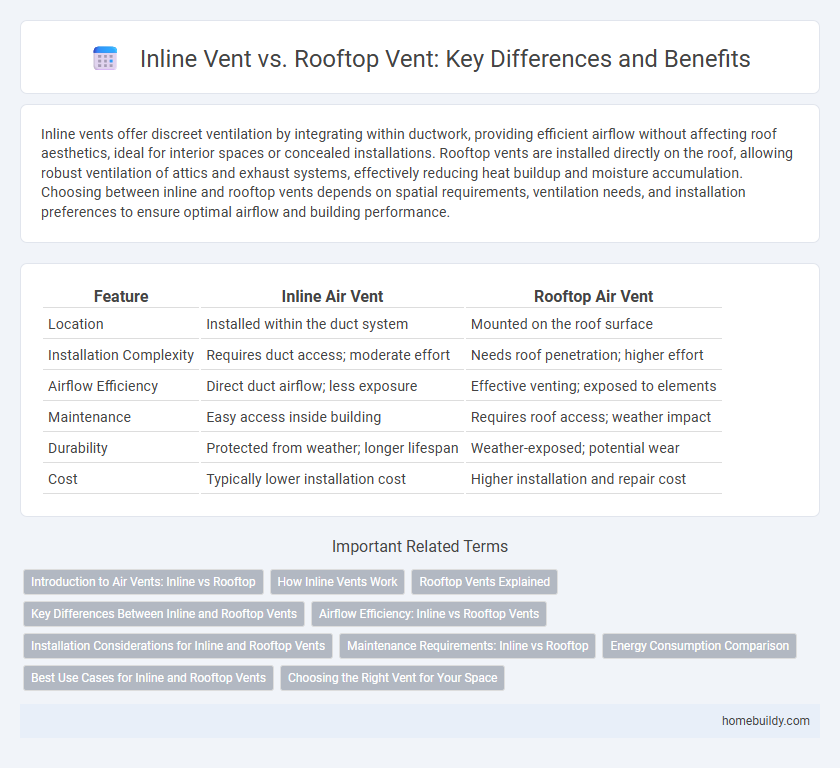Inline vents offer discreet ventilation by integrating within ductwork, providing efficient airflow without affecting roof aesthetics, ideal for interior spaces or concealed installations. Rooftop vents are installed directly on the roof, allowing robust ventilation of attics and exhaust systems, effectively reducing heat buildup and moisture accumulation. Choosing between inline and rooftop vents depends on spatial requirements, ventilation needs, and installation preferences to ensure optimal airflow and building performance.
Table of Comparison
| Feature | Inline Air Vent | Rooftop Air Vent |
|---|---|---|
| Location | Installed within the duct system | Mounted on the roof surface |
| Installation Complexity | Requires duct access; moderate effort | Needs roof penetration; higher effort |
| Airflow Efficiency | Direct duct airflow; less exposure | Effective venting; exposed to elements |
| Maintenance | Easy access inside building | Requires roof access; weather impact |
| Durability | Protected from weather; longer lifespan | Weather-exposed; potential wear |
| Cost | Typically lower installation cost | Higher installation and repair cost |
Introduction to Air Vents: Inline vs Rooftop
Inline vents are installed within the ductwork, providing efficient airflow control and reduced exposure to external weather conditions. Rooftop vents are mounted on the roof, offering direct ventilation for exhaust systems and minimizing indoor air contamination. Choosing between inline and rooftop vents depends on the building design, ventilation requirements, and maintenance accessibility.
How Inline Vents Work
Inline vents operate by channeling airflow directly through ductwork within the roof or walls, allowing for efficient ventilation without roof surface penetration. These vents use a fan mechanism positioned inside the duct to push stale air out and draw fresh air in, maintaining optimal indoor air quality. Compared to rooftop vents, inline vents minimize exposure to weather elements and reduce the risk of leaks, enhancing long-term durability.
Rooftop Vents Explained
Rooftop vents are essential for effective air circulation in buildings, preventing moisture buildup and regulating indoor temperature by allowing hot air to escape through the roof. Unlike inline vents that are installed within ductwork to control airflow, rooftop vents are positioned on the surface of the roof, providing direct ventilation to the attic or roof space. Their durable design and strategic placement reduce the risk of leaks and improve energy efficiency by maintaining balanced ventilation.
Key Differences Between Inline and Rooftop Vents
Inline vents are installed within ductwork to improve airflow efficiency by drawing air directly from the source, offering precise ventilation control and quieter operation. Rooftop vents, mounted on building roofs, facilitate the expulsion of stale air or excess heat from interior spaces, often serving as passive ventilation points with less control over airflow direction. Key differences include installation location, airflow management, noise levels, and maintenance access, making inline vents preferable for targeted ventilation and rooftop vents suitable for broad ventilation needs.
Airflow Efficiency: Inline vs Rooftop Vents
Inline vents provide superior airflow efficiency by minimizing resistance through direct duct connections, resulting in consistent air distribution and reduced energy consumption. Rooftop vents often experience greater airflow resistance due to external environmental factors and longer duct runs, which can lead to decreased ventilation effectiveness. Selecting inline vents optimizes system performance by ensuring smoother air passage and enhanced overall ventilation efficiency.
Installation Considerations for Inline and Rooftop Vents
Inline vents require careful planning to ensure proper alignment within ductwork and are typically easier to install in accessible attic or crawlspace areas, minimizing the need for external roof modifications. Rooftop vents demand precise weatherproofing and structural reinforcements due to exposure to harsh elements and potential roof penetrations, increasing installation complexity and cost. Choosing between inline and rooftop vents depends on building design, ease of maintenance, and local building codes affecting ventilation efficiency and durability.
Maintenance Requirements: Inline vs Rooftop
Inline vents require less frequent maintenance due to their protected location within the ductwork, reducing exposure to external debris and weather elements. Rooftop vents demand regular inspections and cleaning to prevent clogs caused by leaves, dirt, and extreme weather conditions. Proper maintenance of rooftop vents is critical to ensure optimal airflow and prevent water infiltration, while inline vents benefit from easier access during HVAC system servicing.
Energy Consumption Comparison
Inline vents typically offer improved energy efficiency by reducing heat loss through more controlled airflow within ductwork, resulting in lower heating and cooling demands. Rooftop vents often lead to greater energy consumption due to increased exposure to external weather conditions, causing temperature fluctuations that force HVAC systems to work harder. Choosing inline vents can contribute to significant energy savings and reduced utility costs in climate-controlled environments.
Best Use Cases for Inline and Rooftop Vents
Inline vents excel in applications where ductwork runs through confined spaces or long distances, offering efficient airflow control without rooftop modifications. Rooftop vents are ideal for commercial buildings requiring direct exhaust to the exterior, preventing backdrafts and minimizing indoor air contaminants. Choosing between inline and rooftop vents depends on building design, ventilation needs, and maintenance accessibility.
Choosing the Right Vent for Your Space
Inline vents offer discreet installation within ductwork, making them ideal for spaces requiring low-profile ventilation and consistent airflow. Rooftop vents excel in accommodating high-volume exhaust needs and are better suited for large commercial or industrial buildings with easier access for maintenance. Assessing building layout, airflow requirements, and maintenance accessibility ensures the optimal choice between inline and rooftop vent systems.
inline vent vs rooftop vent Infographic

 homebuildy.com
homebuildy.com